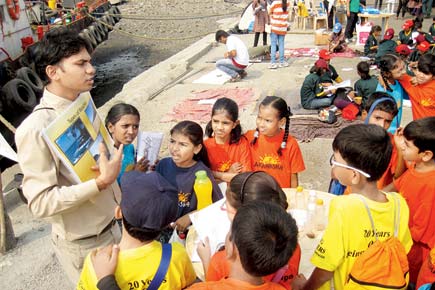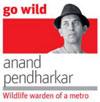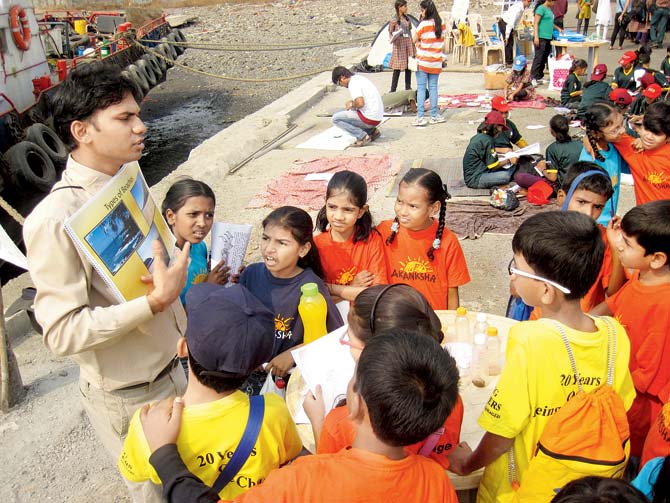Last weekend was a very enjoyable time for my interns and me, as we gathered nearly 150 kids and adults at the Sewri Bay, along the east coast of Mumbai, for our Annual World Wetlands’ Day — Wader and Flamingo Watch

 Last weekend was a very enjoyable time for my interns and me, as we gathered nearly 150 kids and adults at the Sewri Bay, along the east coast of Mumbai, for our Annual World Wetlands’ Day — Wader and Flamingo Watch. It was another of our non-religious, nature-based, outdoorsy and open-to-all nature festival. The event was to commemorate the signing of the Ramsar Convention on Feb 2, 1971, where-by all signatory nations declared their commitment to protecting wetlands.
Last weekend was a very enjoyable time for my interns and me, as we gathered nearly 150 kids and adults at the Sewri Bay, along the east coast of Mumbai, for our Annual World Wetlands’ Day — Wader and Flamingo Watch. It was another of our non-religious, nature-based, outdoorsy and open-to-all nature festival. The event was to commemorate the signing of the Ramsar Convention on Feb 2, 1971, where-by all signatory nations declared their commitment to protecting wetlands.
When I first heard about this declaration and the related day in 1997, I found it absurd and laughable. Why would we need to dedicate a day in a year to think about wetlands? Wasn’t it obvious that we need to protect our water reserves? Well, after nearly two decades and a whole lot of travelling across the country, it seems obvious to me that we urbanites, and in many cases even rural people, don’t realise the value of our wetlands, and the need to dedicate a day or more to their protection, cleaning and rehabilitation.
ADVERTISEMENT
 A volunteer teaches children about wetlands in Mumbai
A volunteer teaches children about wetlands in Mumbai
Wetlands are actually all forms of water bodies composed of fresh, marine or brackish waters. They can be static like lakes, ponds and inland seas or flowing such as streams and rivers. In fact, man-made wetlands such as backwaters of dams and weirs too count as wetlands, as they provide drinking water, food and habitat for a large variety of creatures. Directly and indirectly, these wetlands provide sustenance to traditional occupations such as farmers, potters, fisherfolks, brick-makers, cattle ranchers and even migratory graziers. Besides occupation to humans, they provide natural habitats for lakhs of creatures, both migratory and resident. Wetlands also regulate local temperatures, sequester carbon and act as a sink to reduce our urban heat problems. They are a great aesthetic element in our surroundings and provide opportunities for recreation, water sports, art and music festivals and for even the urban poor to release their stress. A splash under a waterfall is something that trekkers and picnickers enjoy equally during monsoon.
Through our annual Wader and Flamingo Watch Festival, we try to highlight the importance of our urban wetlands to Mumbaikars and give them an opportunity to learn more about their city’s biodiversity. We try to open their eyes to the large number of lakes, talaos, rivers, streams, creeks and mangrove forests that dot the city’s Metropolitan region.
Just to name a few wetlands in Mumbai we have the Bandra, Sion, Aarey and Bhavan’s College talaos; the Banganga and Powai lakes; Mithi, Dahisar and Worli Rivers. Thane has Talao Pali, Panvel has the Ballaleshwar Lake, Vasai has Nirmal among other lakes. The Ullas River basin is a long-winding ecosystem and creates a massive mangrove belt along its course where it meets the Arabian Ocean, along Thane, Kalyan and Mumbai’s coastline. The mangrove pockets of Kalwa-Mumbra-Alimargh, along Airoli-Nerul-Vashi region, Esselworld-Gorai-Marve-Mudh Island regions, Bandra Bandstand-Carter Road and the entire eastern seafront from Mahul-Sewri to Uran are a verdant haven for wildlife.
Sadly, we view our wetlands as some waste dumping location to drain our phenyls, detergents, household sewage and vehicular effluents or to dispose off tube lights, packaging materials, thermocol and party decorations. How myopic is that? Don’t we see the city urchins that are attempting to catch fish that are swimming around in shoals in the reed-lined pools? Visitors to our festival were amazed to see the varied crustaceans and shells we had displayed on our touch-table. Although a few felt dirty, most were elated during our clean-up drive during the festival, picking up bags of garbage that ruins our mangroves. To end the festival on a positive note, we taught the participants to sketch and paint birds and make animal rangolis with flowers. The idea was to highlight the diversity of creatures that the wetlands harbour. Maybe you missed our wetlands’ festival, but just step out to your closest pond, lake, river or beach and rest assured, there is a mega-festival going on, perpetually.
Write in to Anand Pendharkar at sproutsenvttrust@gmail.com
 Subscribe today by clicking the link and stay updated with the latest news!" Click here!
Subscribe today by clicking the link and stay updated with the latest news!" Click here!







